Solar eclipse of September 13, 2015
| Solar eclipse of September 13, 2015 | |
|---|---|
UTC) | |
| Greatest eclipse | 6:55:19 |
| References | |
| Saros | 125 (54 of 73) |
| Catalog # (SE5000) | 9542 |
A partial solar eclipse occurred on September 13, 2015.[1][2][3] A solar eclipse occurs when the Moon passes between Earth and the Sun, thereby totally or partly obscuring the image of the Sun for a viewer on Earth. A partial solar eclipse occurs in the polar regions of the Earth when the center of the Moon's shadow misses the Earth.
Images
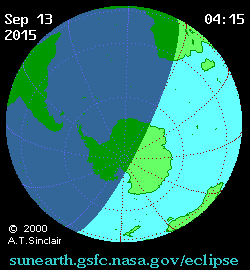 Animated path |
 View from center of sun |
Related eclipses
Eclipses of 2015
- A total solar eclipse on March 20.
- A total lunar eclipse on April 4.
- A partial solar eclipse on September 13.
- A total lunar eclipse on September 28.
Solar eclipses ascending node 2015-2018
- Saros 125: Partial Solar Eclipse September 13, 2015
- Saros 135: Annular Solar Eclipse September 1, 2016
- Saros 145: Total Solar Eclipse August 21, 2017
- Saros 155: Partial Solar Eclipse August 11, 2018
Solar eclipses 2015–2018
This eclipse is a member of a semester series. An eclipse in a semester series of solar eclipses repeats approximately every 177 days and 4 hours (a semester) at alternating nodes of the Moon's orbit.[4]
| Descending node | Ascending node | |||||
|---|---|---|---|---|---|---|
| Saros | Map | Gamma | Saros | Map | Gamma | |
120 Longyearbyen, Svalbard |
2015 March 20 Total |
0.94536 | 125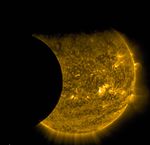 Solar Dynamics Observatory |
2015 September 13  Partial (south) |
−1.10039 | |
130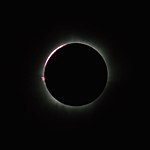 Balikpapan, Indonesia |
2016 March 9 Total |
0.26092 | 135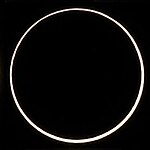 L'Étang-Salé, Réunion |
2016 September 1 Annular |
−0.33301 | |
140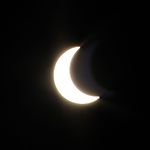 Partial from Buenos Aires |
2017 February 26 Annular |
−0.45780 | 145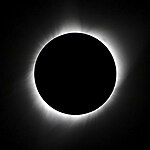 Casper, Wyoming |
2017 August 21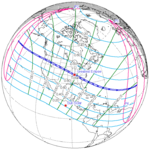 Total |
0.43671 | |
150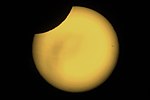 Partial from Olivos, Buenos Aires |
2018 February 15 Partial (south) |
−1.21163 | 155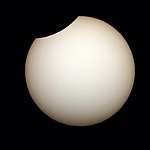 Partial from Huittinen, Finland |
2018 August 11 Partial (north) |
1.14758 | |
Partial solar eclipses on July 13, 2018, and January 6, 2019, occur during the next semester series.
Metonic series
The metonic series repeats eclipses every 19 years (6939.69 days), lasting about 5 cycles. Eclipses occur in nearly the same calendar date. In addition, the octon subseries repeats 1/5 of that or every 3.8 years (1387.94 days). All eclipses in this table occur at the Moon's ascending node.
| 21 eclipse events, progressing from south to north between July 1, 2000 and July 1, 2076 | ||||
|---|---|---|---|---|
| July 1–2 | April 19–20 | February 5–7 | November 24–25 | September 12–13 |
| 117 | 119 | 121 | 123 | 125 |
 July 1, 2000 |
 April 19, 2004 |
 February 7, 2008 |
 November 25, 2011 |
 September 13, 2015 |
| 127 | 129 | 131 | 133 | 135 |
 July 2, 2019 |
 April 20, 2023 |
 February 6, 2027 |
 November 25, 2030 |
 September 12, 2034 |
| 137 | 139 | 141 | 143 | 145 |
 July 2, 2038 |
 April 20, 2042 |
 February 5, 2046 |
 November 25, 2049 |
 September 12, 2053 |
| 147 | 149 | 151 | 153 | 155 |
 July 1, 2057 |
 April 20, 2061 |
 February 5, 2065 |
 November 24, 2068 |
 September 12, 2072 |
| 157 | 159 | 161 | 163 | 165 |
 July 1, 2076 |
||||
References
- ^ Orwig, Jessica. "A NASA video shows what a total lunar eclipse looks like from the moon, and it's mind-blowing". Business Insider.
- ^ European Space Agency. "Image: Proba-2 captures partial solar eclipse". phys.org.
- ^ Wall, Mike (September 12, 2015). "Watch Sunday's Partial Solar Eclipse Live in Slooh Webcast". Space.com.
- ^ van Gent, R.H. "Solar- and Lunar-Eclipse Predictions from Antiquity to the Present". A Catalogue of Eclipse Cycles. Utrecht University. Retrieved 6 October 2018.
